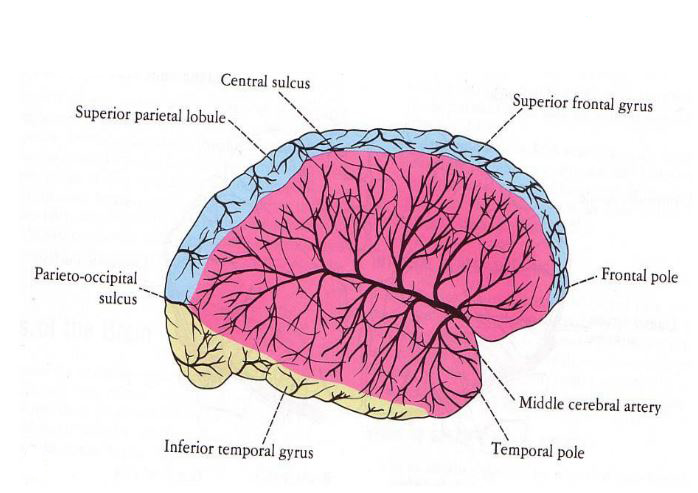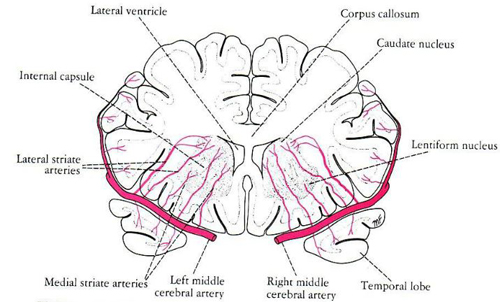Stroke : Common location of vascular lesion Because the nerve fibres are so closely packed in the internal capsule, the consequences of loss of the blood supply to this area can affect the whole of one side of the body - the side opposite the affected hemisphere. In particular there can be paralysis and sensory loss, because important motor and sensory pathways pass though the affected internal capsule. Speech, Understanding and Vision can also be affected because the middle cerebral artey has a wide distribution including Wernicke's and Brocas's areas, and the optic tract and thalamus. |
Three types of stroke can be distinguished:
All three cause serious damage to the brain. |
|
Early Physical Signs of Stroke The following are clear warning signs of a stroke:
Later, following a stroke, there may be:
|
Many strokes are associated with occlusion of the middle cerebral artery. As a result of of the loss of the 'upper motoneurone', i.e disconnection between the cortex and the spinal motoneurones, parts of the brainstem that modulate muscle tone become dominant in their effects on muscle tone and reflexes. These bulbo-spinal pathways are responsible for the changes in muscle tone ('Spasticity'), and reflex excitability, and the changes in the Babinski response seen in stroke patients.. Hypertonus and hyperactive reflexes occur as a result of loss of function in the pre-motor cortex. The weakness and paralysis can cause ataxia - problems with walking and balance. Speaking and understanding may be affected because the middle cerebral artery supplies cortical areas involved in speech and the interpretation of the spoken word - Wernicke's and Broca's areas. Vision may be affected as the Optic Tract receives its blood from the middle cerebral artery. |
|
The distibution of the middle cerebral artery is shown in the diagram. It can be seen that areas of sensori-motor cortex and premotor cortex receive blood from the middle cerebral artery. Also within this are of distribution are areas of cortex concerned with speech, understanding the spoken word, and eye movements. The Internal Capsule is a collection of nerve fibres that pass in the narrow gap between the caudate nucleus and corpus striatum and is commonly affected in stroke because its blood supply comes form the middle cerebral artery (see the diagram opposite. The internal capsule is the main pathway the nerve fibres take between the cortex and the brainstem or spinal cord and is therefore of importance in the control of voluntary movements and in the fine discriminative sensation of touch. More about the Vascular Supply of the Brain |

|
|
Transient Ischemic Attacks (TIAs) Sometimes strokes are preceded by mini-strokes, called transient ischemic attacks (TIAs), that last anywhere from a few minutes to several hours. TIAs result when blood flow to the brain is temporarily interrupted and then restored. TIAs are an important warning sign. It is possible to have several TIAs before a larger stroke occurs. |
|

